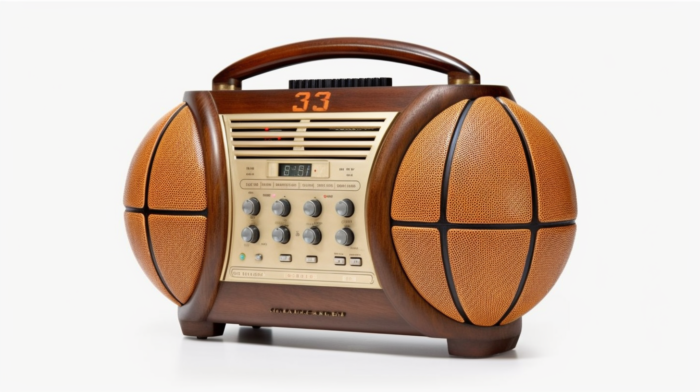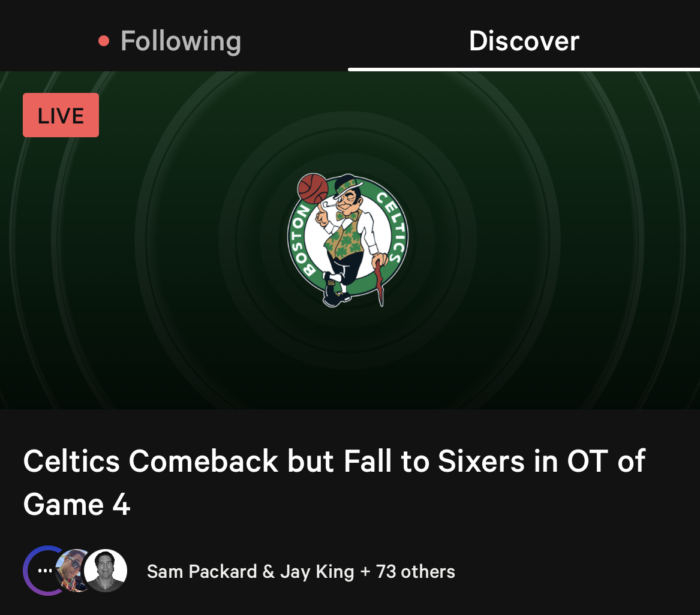
A curious media hole forms in the wake of a big sports game. After the final whistle, people are craving content about what they just watched, but many reporters are busy interviewing coaches and players and writing their stories. That’s a void just when fans are most desperate to process what happened and what it all means for the team.
Postgame is one of the times when The Athletic’s live rooms shine. The writer-hosted live rooms — which sometimes get called “live podcasting” because the finished results are often posted to podcast feeds — are a two-way audio platform for Athletic beat reporters to have conversations with subscribers. If you’re a longtime sports fan who has turned an AM/FM dial or two in your day, the format might feel familiar.
“Technology is cyclical in a lot of ways,” Will Bartlett, The Athletic’s senior audio development specialist, acknowledged. “It feels like we’ve just reinvented sports talk radio, just making it a little bit more accessible to people in the 21st century.”
“We try to encourage writers to do it around Moments with a capital ‘m,’” Bartlett added. “So when, you know, the Celtics lose on a last-second shot from James Harden and the Sixers, let’s try and get on there as quickly as possible. People are going to be on edge and wanting to vent to [The Athletic’s Celtics reporter] Jay King the way they would want to vent to [Boston-area sports radio] WEEI or something like that.” (Boston sports fans on edge? Can’t imagine it!)

The live rooms I’ve joined do replicate the fun ephemerality of sports radio and — more recently — certain struggling social audio apps. The Athletic’s live rooms are recycled into specific team podcasts and league-level feeds, but most are not exactly evergreen content. Anyone can listen in, but only subscribers can ask questions using the chat-like text box or being invited to speak by one of the hosts. Non-subscribers run into The Athletic’s paywall after clicking on one article, so live rooms are one of the only ways readers can sample the outlet’s content before getting their wallet out.
The Athletic’s first live room took place in September 2021. By January 2022, they’d done 100. Today, they’re closing in on 1,000 live rooms. Most have between 50 and 250 listeners. They tend to follow a similar format: the beat writer(s) give a “State of the Union”-like update about the team before opening the floor to questions, comments, and provocations from listeners.
“It’s sort of an in-app version of Twitter Spaces for us,” Bartlett said.But, unlike Twitter Spaces, the live rooms exist on The Athletic’s app. With prominent cautionary tales about what relying on social media platforms can do to a newsroom ringing in our ears, The Athletic’s choice to build on its own turf makes plenty of sense.
The Athletic prompts all subscribers to follow a team or league and uses these preferences to build a user’s homepage — and to send push notifications when a live room begins. A user who has followed tags for football’s Cincinnati Bengals and the NFL at large, for example, might get pinged for a live room about Cincinnati’s draft picks as well as league-wide news like quarterback Aaron Rodgers being traded to the New York Jets — even if the breaking story discussed in the live room isn’t about their local team.
The majority of listeners make their way to the live rooms through those push notifications from the newsroom’s app, Bartlett said. Others find them through organic discovery (i.e. clicking around in the app) and social media.
If looking to kill time and fill your brain with even more #Bengals draft theories and rumors, @JayMorrisonATH & I are doing a live room on @TheAthletic app at noon today.
Anyone can listen, subscribers can ask questions. Come on over. https://t.co/rNhRwlWtxI
— Paul Dehner Jr. (@pauldehnerjr) April 27, 2023
No podcast today because @thrace and I are gonna hang out in a live room on @TheAthletic tomorrow to discuss #NWSLChallengeCup and anything else y’all want to talk about!
2 ET. Bring snacks and questions. (And if you miss it live, it will be a podcast episode right after!) pic.twitter.com/LbxqdBxA6d
— Meg Linehan (@itsmeglinehan) March 17, 2022
Scheduled off day for the #STLCards today, but still plenty of things to talk about!
Let’s do a one-hour trade deadline live room at 12 pm CT. You don’t need to be a subscriber to @TheAthletic to join, but you do need to subscribe to ask questions.
Link posted here at 12.
— Katie Woo (@katiejwoo) August 1, 2022
When going live postgame, journalists and fans rehash missed opportunities, on-the-field celebrations, and more. During the offseason or in pregame coverage, the group can prognosticate and predict to their hearts’ content. The whole time, both writers and those invited to speak can assume they’re among fellow diehard fans. In my corner of the sports world, that means Jay King might feel free to mention the Kornet contest — a goofy vertical leap a certain Boston bench player attempts even when half a court away from the shooting player — one moment and, the next, dive into bigger-picture narratives like how two of the team’s brightest stars work together or how All-NBA selections could shape the team’s future.
There aren’t strict requirements or quotas for Athletic reporters around the live rooms. (“Our writers are writers first and foremost,” Bartlett said. “We want these to be something that writers want to do. There’s never going to be a mandate around these.”) But for new hosts looking for guidance, Bartlett encourages them to slot something in between 8 a.m. and 10 a.m. or between 4 and 6 p.m. local time. Noon has also proven to be a popular option, presumably because listeners are tuning in during lunch breaks.
“We’ve definitely seen our highest rates of engagement around times that you would see in traditional sports radio, including those commuting times,” Bartlett said. “One advantage that we do have over traditional sports talk radio is the ability to send push notifications to all of our followers at different times.”
The largest audiences haven’t always been for rooms about teams in the largest cities. The beat writers who cover the Cincinnati Bengals host a popular live room every Monday at noon. Live rooms from a writer who covers NHL’s Minnesota Wild team were popular enough to break the app a couple of times. The beat writer for the St. Louis Cardinals also tends to draw a crowd.“Not a lot of those [locations] are super-saturated markets in terms of news coverage,” Bartlett said. “This is a way for us to serve some of the markets [that] don’t have national writers living there or ESPN there every day — but we happen to have a very well-plugged-in writer in that spot.”
Katie Woo, the staff writer for The Athletic who covers the St. Louis Cardinals, said she likes being able to drop information and ideas she might not use in a story in live rooms.
“It’s a great way to make fans and subscribers feel connected to their teams,” Woo said. “Being able to have people call in and actually ask their questions in real time to a real voice, instead of debating online, has led, in my opinion, to productive conversations.”
A lot of listener questions are hypotheticals, “usually pertaining to roster moves, trades, or free-agent signings,” Woo said. She occasionally gets story ideas from the conversations, she added, “but the main reason I use the rooms is [that] it helps me feel more connected to the subscribers. Hopefully they feel the same.”
Saad Yousuf, who covers the Dallas Stars for The Athletic, recently held his first live room. (He has a side gig hosting a weekly radio show in Dallas, so he’s not exactly new to audio.) He described the live two-way audio form as a “great supplemental tool” for his written coverage.
“The fans who joined the live room are subscribers who read my work routinely, which differentiates it from something like Twitter Spaces, where anybody can join, even if they aren’t subscribers,” he said. The rooms help him “get a pulse” on which topics readers feel most strongly about, and which questions he should make sure to answer in his next article.
Bartlett said the live rooms can be a type of training ground — an opportunity to get some audio reps in — for writers who may eventually launch a podcast or earn a hosting gig on an existing show with The Athletic. “It’s one way for us to identify talent down the road,” he said.
With more than 800 live rooms completed, The Athletic has had roughly 2,000 people get “on stage” to ask questions live. Hosts have moderation tools, similar to the ones Twitter Spaces offers, but Bartlett says said they’ve had “zero trolls” thus far. From what I’ve heard, plenty of subscribers “call in” with a question-that’s-more-of-a-colorful-rant that brings legendary sports radio meltdowns to mind but, overall, there’s less casual racism and sexism.
“It’s one of the more positive places on the internet, for the most part,” Bartlett said. “People are just there to talk sports.”